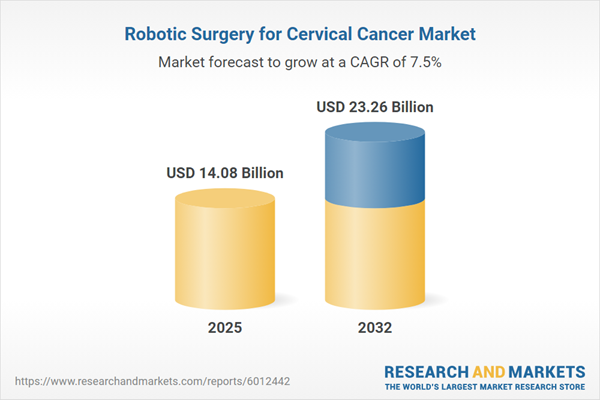Speak directly to the analyst to clarify any post sales queries you may have.
Senior healthcare executives face accelerating change within the robotic surgery for cervical cancer market. Staying informed on evolving technologies, procurement frameworks, and operational demands is key to maintaining strategic advantage and delivering optimal care outcomes within a complex landscape.
Market Snapshot: Robotic Surgery for Cervical Cancer Market
The global robotic surgery for cervical cancer market is valued at USD 13.09 billion, expanding at a 7.45% CAGR. Market projections indicate growth reaching USD 14.08 billion by 2025 and an estimated USD 23.26 billion by 2032. This expansion is supported by continuous innovation in robotic surgery platforms, upgraded healthcare infrastructure in mature and emerging economies, and policy improvements in reimbursement. As organizations confront rapid technological and regulatory developments in robotic surgery for cervical cancer, refined procurement approaches and investment planning are essential to capture ongoing opportunities and maintain market relevance.
Scope & Segmentation: Robotic Surgery for Cervical Cancer Market
This report delivers in-depth segmentation, empowering leaders to align decisions with both organizational strategy and local operational realities. Key covered segments include:
- System Types: Multi-port and single-port systems support flexible system selection suitable for various procedural demands and throughput requirements.
- End Users: Ambulatory surgical centers, acute care hospitals, and specialized cancer clinics each benefit from tailored solutions that address differences in care delivery and resource allocation.
- Applications: Radical and simple hysterectomy procedures, lymphadenectomy, as well as interventions for advanced-stage cervical cancer, extend the clinical utility of robotic surgery platforms.
- Components: Surgical instruments, maintenance offerings, structured training programs, and decision-support analytics tools enhance operational efficiency and minimize costly downtime across facilities.
- Service Models: Capital purchase options, equipment leasing, pay-per-use models, and customized financing provide institutions with diverse pathways to adjust investment strategy to budgetary and operational constraints.
- Technologies: The integration of artificial intelligence, haptic feedback, automated suturing, and unified imaging from modalities such as CT, MRI, and ultrasound enables higher surgical precision and supports data-driven care decisions.
- Regions Covered: Strategic insights span the Americas, Europe, Middle East and Africa, and Asia-Pacific, addressing the regulatory and infrastructural realities unique to each area.
- Company Coverage: Profiles include Intuitive Surgical, Medtronic plc, Johnson & Johnson, Stryker Corporation, Zimmer Biomet Holdings, Smith & Nephew, CMR Surgical Ltd, Asensus Surgical, Medrobotics Corporation, and Renishaw plc, benchmarking innovation and partnership dynamics across the sector.
Key Takeaways for Senior Healthcare Decision-Makers
- Robotic platforms can standardize and streamline surgical workflows, supporting minimally invasive approaches that enhance both patient outcomes and care team satisfaction.
- Artificial intelligence capabilities and modular system architectures allow health systems to expand technology over time, matching clinical requirements and case diversity.
- Industry consolidation creates new negotiation opportunities and may accelerate the upgrade of surgical suites and procurement methodologies.
- Flexible financing structures such as leasing and pay-per-use models increase technology accessibility for all facility sizes, supporting equitable care.
- Remote education and analytics-based training foster continuous workforce upskilling, supporting consistency and quality of surgical delivery across disparate locations.
- Regionally adapted initiatives ensure smoother compliance with local reimbursement, regulatory, and infrastructure complexities, enabling responsive adoption strategies.
Tariff Impact: Supply Chain Considerations in 2025
Projected shifts in U.S. tariffs continue to exert pressure on the supply chains for robotic surgery systems, leading to pricing adjustments for some specialized components. Suppliers are diversifying global sourcing and streamlining internal operations to help offset risk. In response, healthcare organizations are renegotiating with vendors and targeting improved operational efficiency. Flexible procurement models, such as equipment leasing and outcome-based agreements, are being leveraged to ensure ongoing access to critical platforms, reducing vulnerability to temporary supply fluctuations and preserving care standards.
Methodology & Data Sources
This market study is informed by direct interviews with surgeons and executives, supply chain insights, and manufacturer verification. Supplementary data from structured surveys, regulatory and patent evaluations, and clinical studies provide a rigorous foundation for the report’s findings.
Why This Report Matters
- Supports leadership in optimizing procurement and investment by drawing on current, validated data for robotic surgery for cervical cancer.
- Clarifies the forces driving technology adoption, assisting senior teams in allocating resources and sharing insights with stakeholders across institutional and geographic boundaries.
- Prepares executives to proactively address evolving operational and policy landscapes that can affect the successful deployment of robotic surgical solutions.
Conclusion
The robotic surgery for cervical cancer market is transforming clinical practice and operations. With this report, healthcare leaders gain the focused insight required to adapt strategies, drive organizational value, and strengthen resilience within a fast-evolving field.
Additional Product Information:
- Purchase of this report includes 1 year online access with quarterly updates.
- This report can be updated on request. Please contact our Customer Experience team using the Ask a Question widget on our website.
Table of Contents
3. Executive Summary
4. Market Overview
7. Cumulative Impact of Artificial Intelligence 2025
Companies Mentioned
The companies profiled in this Robotic Surgery for Cervical Cancer market report include:- Intuitive Surgical, Inc.
- Medtronic plc
- Johnson & Johnson
- Stryker Corporation
- Zimmer Biomet Holdings, Inc.
- Smith & Nephew plc
- CMR Surgical Ltd
- Asensus Surgical, Inc.
- Medrobotics Corporation
- Renishaw plc
Table Information
| Report Attribute | Details |
|---|---|
| No. of Pages | 185 |
| Published | October 2025 |
| Forecast Period | 2025 - 2032 |
| Estimated Market Value ( USD | $ 14.08 Billion |
| Forecasted Market Value ( USD | $ 23.26 Billion |
| Compound Annual Growth Rate | 7.4% |
| Regions Covered | Global |
| No. of Companies Mentioned | 11 |









